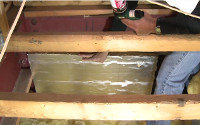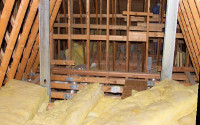Videos
Your Local Contractor is:
Mid-State Home Services
Change Location
Your Local Contractor is:
Mid-State Home Services
Change Location
On this episode of Dr. Energy Savers' On The Job Series, Larry Janesky, owner and founder of Dr. Energy Saver, demonstrates how multi-level attics can be difficult to insulate because of the different dimensions in attic floors. If the multi-level attic isn't properly insulated it could significantly impact the home in terms of energy efficiency and comfort.
Multi-level attics are formed when there is a difference in ceiling height between two rooms. The difference in ceiling height creates spaces that are hard to access and therefore hard to insulate and air seal. These areas are often overlooked during construction, and they usually become gaps in the building envelope.
Unusual architectural features, such as multi-level attics, make a home unique by giving it personality and helping to define the building's style.

In this house there was a 3 foot step in between the lower ceiling and the upper ceiling, forming an exposed interior wall space in the attic (multi-level). Most houses have around 8 foot ceilings, but some houses with complex and unusual architectural features create differences in ceilings from room-to-room.

As you can see, the multi-level attic of this home has about a 3 foot difference between the top and lower ceiling, creating a large interior hollow wall. If not properly air sealed and insulated, the multi-level attic will cause heat from the living area to be lost to the un-vented, cold attic during the winter, through this open wall cavity.
In the summertime, cool, conditioned air will escape and the scorching heat from the attic will transfer to the living space putting a burden on your air conditioning system.

Each multi-level attic presents a separate insulation challenge, as some ceilings may differ between heights and odd structural dimensions. With different dimensions in each multi-level attic, there demands a custom-designed solution to fix it. In this video, you'll notice how Larry uses SilverGlo insulation, a rigid foam board with a radiant barrier, to insulate the portion of the wall protruding from the attic floor.
There are several techniques and insulation materials that can be used to close these gaps and the choice will depend on specific features of the area in question.

If insulated properly, attics can become the most important feature of an energy-efficient home. In the attic, gaps and leaks in insulation are usually the number one source of energy loss. This is especially true in multi-level attics, where small portions of the walls usually protrude from the attic floor.
Are you experiencing inexplicably uneven temperatures around the home, with some rooms that are either much colder or much hotter than others? Does your home feel drafty or damp? Dr. Energy Saver, can help you fix all these problems and make your home more comfortable and affordable to own, by properly insulating the attic.
If your home has a multi-level attic or any other architectural feature that can potentially impact your home's energy efficiency and comfort, call or contact your local Dr. Energy Saver today for a free estimate and evaluation. We can make your home more comfortable, and much more affordable to own!
Areas Served